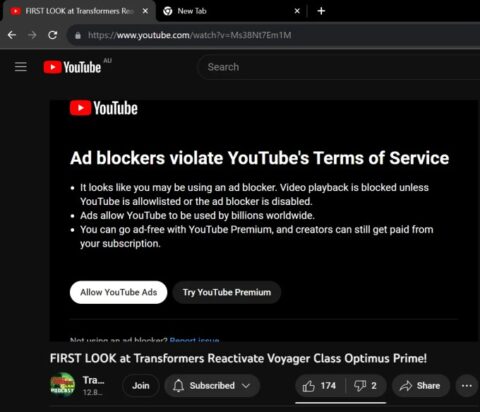YouTube is now cracking down on ad-blocker usage globally, by showing warnings about breaking the platform’s terms of service. In some cases, the company is preventing users from […]
Does X’s new valuation make sense?
News that X (formerly Twitter) is now valued internally at $19 billion has unleashed a wave of snickering from critics of Musk and his recently renamed social network. […]
How to watch ‘A Haunting in Venice’ on Hulu
These are the best ways to watch ‘A Haunting in Venice’ on Hulu. Find out if you qualify for a free trial.

Hulu monthly subscription

Disney Duo Basic Bundle (Hulu and Disney+ With Ads)
(save $5.99/month)

Hulu Basic (with ads)
(save $7.99/month)

Spotify Premium for Students with Hulu
(save up to $12.99/month)

Hulu (with ads) annual subscription
(save 17%)

Scary movie season continues to deliver when it comes to streaming. A Haunting in Venice, the latest Hercule Poirot murder mystery film by Kenneth Branagh, fittingly hits the streaming world on Halloween. It will also be available to buy digitally the same day from all major digital retailers (Prime Video, Apple TV, Fandango/Vudu, etc. with behind-the-scenes bonus content).
Like Branagh’s other two Poirot flicks, Murder on the Orient and Express and Death on the Nile, A Haunting in Venice has a stacked cast including Michelle Yeoh, Tina Fey, Kyle Allen, Camille Cottin, Jamie Dornan, Jude Hill, Ali Khan, Emma Laird, Kelly Reilly, Riccardo Scamarcio, and of course, himself as Hercule Poirot. The film will officially be available to stream on Hulu just in time to cap off the streamer’s iconic “Huluween” event. Here’s everything you need to know to watch A Haunting in Venice.
Can I watch A Haunting in Venice at home?
Still showing in select theaters nationwide, you can check out A Haunting in Venice on the big screen if you wish. However, if you prefer to watch the Agatha Christie adaptation from your couch, it’s coming to small screens just in time for a Halloween watch party. The film begins streaming on Hulu on Oct. 31 for subscribers. Conveniently the previous two films in the trilogy — Murder on the Orient Express and Death on the Nile — are streaming on Hulu as well.
Can you watch A Haunting in Venice online for free?
The good news is Hulu offers a generous free trial for an entire month — plenty of time to watch A Haunting in Venice and all sorts of other scary flicks. The bad news is it’s only for new (and some returning) subscribers. However, that’s not the only way to watch A Haunting in Venice online for free — or, at least, at a discount. Sprint customers and students also have ways to score a free subscription. Here’s what you need to know.
How to get Hulu for free
Best for most people: Hulu 30-day free trial

Opens in a new window
In a streaming market flooded with inflated prices, it’s getting harder and harder to score a free trial. Hulu is one of the most generous streamers, however, offering a substantial 30-day trial to test the waters. If you’ve never been a Hulu subscriber in the past, you can take advantage of your free trial (which is valid for both the No Ads and With Ads plans) right around Halloween. That will allow you to watch A Haunting in Venice when it premieres on the streaming service, plus Murder on the Orient Express, Death on the Nile, and more.
You’ll have to dish out either $7.99/month for the With Ads plan or $17.99/month for the No Ads plan to continue your subscription or cancel before your 30 days are up.
Note: Some returning subscribers will also be eligible for the trial, depending on how long it’s been since you’ve been a subscriber.
Best for Sprint customers: Hulu (With Ads) monthly subscription

Opens in a new window
If you’re on a Sprint Unlimited plan, you can unlock free access to Hulu’s With Ads plan — so long as it remains active and in good standing. (If you choose to switch plans or cancel, your subscription will be suspended.)
Just head over to the Sprint (which is now T-Mobile) website, choose “activate now,” and sign into your Sprint account. From there, choose the phone you want to enjoy Hulu on, click “change service add-ons,” and choose Hulu. You’ll then receive a text message to follow and complete your account setup.
Best for students: Spotify Premium for Students with Hulu

Opens in a new window
Spotify Premium for Students with Hulu
Students have a few awesome options for watching A Haunting in Venice and other eerie faves on Hulu. Our personal favorite is signing up for Spotify Premium for Students. Not only will you get a free one-month trial, but you’ll also unlock access to Hulu With Ads for no extra charge. Following your trial period, you’ll have to pay only $5.99/month for both Spotify Premium and Hulu. There’s just one catch: you need a .edu email address to prove you’re a student (verified through SheerID).
Another option, which also requires the same .edu email address rules, is to open a Hulu student account on its own. There’s currently no free trial offered, but you’ll only have to pay $1.99/month, which is practically a steal.
Other ways to watch A Haunting in Venice
If you don’t qualify for the free options above, all hope is not lost. You can still save money on a Hulu subscription — it just won’t be free. If you commit to a full year of streaming, you can save 16% by choosing an annual subscription rather than a monthly subscription. You could also choose to only subscribe for a single month, then immediately cancel. Technically, you won’t save any money this way, but you also wouldn’t waste any.
Want more bang for your buck? You could opt for the Disney Bundle Duo, which includes Hulu and Disney+ (or Bundle Trio with Hulu, Disney+, and ESPN+), which could save you up to 49%. Not interested in signing up for another streaming service? Purchase it on digital and call it a day.
Best for long-term viewing: Hulu (With Ads) annual subscription

Opens in a new window
Opting for an annual subscription rather than a monthly subscription will knock the $7.99/month cost down to only $6.67/month. Yes, you’ll pay more upfront, but in the long run, you save about 16%. If you also qualify for the free one-month trial (mentioned above), the price would drop down to just $6.15/month for 13 months.
By paying for a year, you’ll have plenty of time to watch A Haunting in Venice, plus Branaugh’s other two Hercule Poirot films, Murder on the Orient Express and Death on the Nile. You can even dive into plenty of other Hulu Originals we highly recommend, like The Bear, Tiny Beautiful Things, and Only Murders in the Building.
Best bundle deal: Disney Duo Basic or Trio Basic Bundle (With Ads)

Opens in a new window
The Disney Duo Basic Bundle is one of the best streaming deals around. For just $9.99/month, you’ll get access to all of the content on Disney+ and Hulu. That’s just $2 more than paying for Hulu on its own. If you’re a sports fan, you can opt for the Trio Basic Bundle and throw ESPN+ in the mix as well for $14.99/month, saving you 44%.
Sure, it’s not the best choice if you’re only looking to watch A Haunting in Venice and be on your way, but if more bang for your buck is what you’re looking for, the Disney Bundle is one of the best options.
Best non-streaming option: Buy A Haunting in Venice on digital
A Haunting in Venice is set for a digital release on the same day as its Hulu streaming debut. That means those who wish to add it to their digital library, rather than sign up for another streaming service, can do so at retailers like Apple TV, Amazon Prime Video, or Vudu (links not yet available). The best part about purchasing a digital version is the lineup of bonus features that come with it. Bonus features include behind-the-scenes footage of bringing the Agatha Christie classic Hallowe’en Party to life, set building, deleted scenes, and more.
Is ‘When Evil Lurks’ streaming? Where to watch the horrifying possession film at home.
Where to watch the horror film ‘When Evil Lurks’ at home, including the best streaming deals.

Shudder
(save $6.99)

Shudder Prime Video add-on

AMC+

AMC+ Prime Video add-on

Horror fanatics, gore enthusiasts, and demonic film devotees looking for a scary movie to rev up those Halloween engines, When Evil Lurks is officially available for your streaming pleasure. If you can stomach it, that is.
When Evil Lurks tells the tale of a demonic infection that begins in a nearby farmhouse and spreads across a rural community through heinous possession and cruel violence. The two main characters, brothers Pedro (Ezequiel Rodriguez) and Jimmy (Demián Salomón), attempt to rid the town of evil, and upon failing, attempt to flee from it. But, as Mashable’s film critic Kristy Puchko puts it, “you should know this is not a story with a happy ending.”
Here’s a taste of what you’re in for:
Where is When Evil Lurks streaming?
When Evil Lurks is still in select theaters, but as of Oct. 27, you can also watch it on smaller screens at home. It made its streaming debut on Shudder — a streaming platform dedicated to horror — just in time for a Halloween viewing sesh and is streaming on AMC+ as well. Here are all the best ways to sign up and stream the horrifying possession tale.
Best for horror fans: Shudder subscription

Opens in a new window
Horror fanatics who want to watch When Evil Lurks for free should definitely take advantage of the 30-day free Shudder trial. Just enter the code FRIGHTRAGS in the promo code box and the seven-day trial will turn into a 30-day trial for you to poke around and watch as many freaky films as you desire.
Want to keep your subscription after your trial period ends? It’ll cost you $71.88 (or $5.99/month) if you pay for an entire year upfront or $6.99/month if you opt for a monthly membership. Either way, your subscription will automatically renew until you cancel. Note that the free trial is only available for new or returning subscribers.
Best for Amazon Prime users: Shudder Prime Video add-on

Opens in a new window
If you’re an Amazon Prime Video subscriber, you can subscribe to Shudder as an add-on to your account. That way, you don’t need to remember yet another password and download another app. You can simply access When Evil Lurks and other horror films on Shudder via your Prime Video account. You can test things out for seven days before fully committing — which gives you plenty of time to watch When Evil Lurks — then decide whether you want to keep your subscription going for $6.99/month. You can cancel at any time in your Amazon account details.
Best for more than just horror: AMC+ subscription

Opens in a new window
If you want to watch When Evil Lurks, but don’t necessarily want to subscribe to an all-horror streaming service, AMC+ is a better option for you. It has a splash of Shudder’s content, including When Evil Lurks, plus AMC content, IFC Films, BBC America, Sundance Now, and more. In other words, it offers a lot more than just horror films. You can kick things off with a seven-day free trial, then you can choose to subscribe for as low as $4.99/month (if you don’t mind ads). Just remember that your subscription will auto-renew until you cancel.
Honorable mention: AMC+ Prime Video add-on

Opens in a new window
Like the Shudder add-on, you can tack AMC+ onto your Amazon Prime Video account. The only downfall is that after your seven-day free trial, it’ll auto-renew for the most expensive $8.99/month plan without the option to downgrade your account. It’s still a great way to watch When Evil Lurks for free, but just remember to cancel before your seven-day trial is up if you don’t want to be charged full price.
Facebook and Instagram launch ad-free subscription in Europe
Meta now offers users in the EU, EEA, and Switzerland a monthly subscription fee to use Facebook and Instagram without ads.

It’s not particularly surprising, but it is pretty exciting: In a decision that could change the way we interact with social media companies, Meta is offering a monthly subscription fee to use Facebook and Instagram without any ads for users in the EU, EEA, and Switzerland.
Beginning in November, users will be able to pay €9.99 per month on the web or €12.99 per month on iOS and Android to use Facebook or Instagram without ads, and, while subscribed, their information will not be used for ads. It’s more expensive on iOS and Android because of the app store fees, Meta said in a statement. The subscription will apply to all of your accounts until March 1, 2024 — so if you have a public Instagram account and a finsta, both will be covered under your subscription.
After March 1, 2024, you’ll have to pay an additional €6 per month on the web and €8 per month on iOS and Android for each additional account. There will still be the option to use the services for free and continue to see ads.
“We believe in an ad-supported internet, which gives people access to personalized products and services regardless of their economic status,” Meta said in a statement. “It also allows small businesses to reach potential customers, grow their business, and create new markets, driving growth in the European economy. And like other companies, we’ll continue to advocate for an ad-supported internet, even with our new subscription offering in the EU, EEA, and Switzerland. But we respect the spirit and purpose of these evolving European regulations, and are committed to complying with them.”
Social media runs on ads — we know this. If Meta can keep you on its platform longer, you’ll see more ads, paying Meta more money, and the cycle continues. Ads likely make Meta more money than a subscription fee ever could, so it’s clear that this change was born from a fight between Meta and legislators, not just a kindness from the social media giant.
This comes amid a years-long battle between EU regulators and Meta due to the company’s data collection practices and the EU’s GDPR, a 2016 law that protects people’s online privacy and data.
Meta to offer ad-free subscription in Europe in bid to keep tracking other users
Meta is to offer an ad-free subscription version of Facebook and Instagram in the European Union, EEA (European Economic Area) and Switzerland, confirming the core of a report […]
Twitter / X posts with misinformation are no longer eligible for ad revenue sharing
Twitter / X owner Elon Musk has announced it is disabling ad revenue sharing on posts which are corrected by Community Notes fact checks.

Twitter / X owner and executioner Elon Musk has announced that the platform is disabling ad revenue sharing on posts which are corrected by Community Notes fact checks. The aim is to make sharing incendiary false information on Twitter / X less obviously and immediately profitable.
“Any posts that are corrected by @CommunityNotes become ineligible for revenue share,” Musk wrote on his official account on Sunday. “The idea is to maximize the incentive for accuracy over sensationalism.”
Implemented earlier this year, Twitter / X’s ad revenue sharing program gives users a cut of the income from ads shown in the replies to their posts. The program is only available to users with a paid X Premium or Verified Organization account, and they must also have at least 500 followers as well as a minimum of 5 million organic impressions in total across all their posts within the last three months.
Unfortunately, it’s widely believed that social media posts are more likely to go viral if they are divisive, polarising, negative, or include misinformation. So if you were aiming to maximise your potential Twitter / X ad revenue earnings prior to today, you were essentially incentivised to make posts which included such content.
Having specific posts ineligible for ad revenue still won’t stop verified accounts from continuing to peddle misinformation, but at least they’ll have one less reason to do so.
Musk also attempted to address the possibility of people abusing Twitter / X’s new policy by using Community Notes’ crowd-sourced content moderation with the intent to restrict an account’s potential ad revenue.
“Worth ‘noting’ that any attempts to weaponize @CommunityNotes to demonetize people will be immediately obvious, because all code and data is open source,” Musk claimed.
It’s unclear exactly whether such data transparency will actually prevent people from applying Community Notes to strategically demonetise accounts, or whether it will simply be apparent when they do.
Interestingly, Musk did not mention any intention to disable ads on posts that have been corrected by Community Notes, making this new policy seem like a win-win for Twitter / X. While the company will no longer explicitly reward users who spread mis- or disinformation, it will presumably still reap the ad revenue rewards of such posts for itself.
Photo-sharing app Lapse appeals to users who want a more personal social media experience
Lapse, a photo-sharing app with a film filter, shot to the top of the App Store thanks to a clever gimmick. But can its users get hooked on yet another social media app?

It’s a truth universally acknowledged that social media sucks right now.
Platforms are overrun by ads and sponsored posts, and algorithms don’t prioritize the social aspect of digital connection. The swift rise and fall of BeReal, an app that offered a solution to the disappointing state of the social media landscape, now seems more like a cautionary tale. That’s not stopping developers from trying to revolutionize the way we connect online, and Lapse is the latest alternative social media app on the scene.
It advertises itself as “the invite-only disposable camera.” On Lapse, you take a photo (called a “snap”) and send it to the “darkroom” to be “developed.” At an unspecified time later in the day, you’ll get a notification that your photo is ready, and you can see the photo you took transformed by Lapse’s grainy, analog filter. Once you see the photo, you can decide whether to post it in your gallery or archive it.
Lapse forgoes an algorithmic feed and aims for something more personal and chronological. Snaps live on your profile, or your “Journal,” which can be customized with music, a carousel of select images, your zodiac sign, and emojis. Meanwhile, your friends can react to your snaps, or share a “vibe,” with a range of pre-selected randomized emojis.

Credit: Lapse: @crystalbbell
The photo app remixes aspects of other platforms to create a unique, yet familiar experience. It incorporates the camera roll archive of Snapchat, the film-like filter of Dispo, the photo-sharing element of Instagram, and the low-stakes, low-key nature of BeReal.
The darkroom gimmick of Lapse encourages users to live in the moment and take a photo and go, contrary to the fraught Instagram experience of taking dozens of photos and immediately scrutinizing them for posting potential or the instant gratification of BeReal.
“With Instagram now, I feel like you have to think long and hard about what’s going to be on your feed, but if I want to take a picture of the fucking chicken fingers that I made, then I can post it on Lapse,” Daniel Head, a 32-year-old Lapse user in Brooklyn, New York, told Mashable.
Lapse isn’t new — it first launched in 2021 as a collaborative disposable camera roll app — but in June, it rebranded to more of a traditional social media platform with profiles where users could share their “developed” photos and organize them into monthly “memories” and albums. At its launch, Lapse raised $11 million in seed round funding.

Credit: Lapse
In the last month, you’ve likely received a cryptic text message from a friend along the lines of “we need this,” accompanied by an early access invite to Lapse. The platform requires new users to invite five or eight friends via text message before they can start using it. At the end of September, it shot up from No. 118 to No. 1 in the App Store — it currently sits at No. 2 — as a result of this growth hack. According to data.ai, Lapse had nearly 1.2 million users worldwide in late September.
Joshua Santos, a 27-year-old software engineer in Phoenix, Arizona, started using Lapse at the beginning of October. “It felt off that I had to invite other people just so I could use the app,” Santos told Mashable. “It was like some weird pyramid scheme.”
The app co-founders Dan and Ben Silverton stand by their onboarding process. Dan told TechCrunch, “We are top of the charts because Lapse is resonating with young people, who are sharing millions of photos per day in our app. They are exhausted by existing photo-sharing apps, and Lapse is a way for them to live in the moment and share memories pressure-free.” It also clearly benefits from young people’s insatiable nostalgia for vintage tech following the disposable camera boom in 2019.
But texting friends isn’t the only requirement to access Lapse. “You have to add the [Lapse] widget to your home screen or your lock screen, which is kind of wild. Like, oh, OK, we’re really being invasive with it,” explained Head.
Other users, like Ria Bhagwat, don’t mind the widget. “[The widget] is very engaging. It convinced me to want to use it more,” the 23-year-old freelance journalist told Mashable.
The platform successfully gamed the system for downloads, but can its users get hooked on yet another social media app? BeReal taught us about how quickly the novelty of a new social platform can wane, and while Lapse is breaking through without the incentive to use it daily, its staying power remains unclear.
But so far, Bhagwat is hooked. She posts on Lapse two to three times a day to 50 friends. “I am not usually a fan of photo apps. I had Snapchat in college. It forced me to always be on high alert about how I looked or what I was doing,” explained Bhagwat. “Lapse is nice because a lot of people use it for scenery. It’s different from Snapchat or BeReal because it’s not focused on the person who is posting, it’s more what they’re doing or who they’re with.”
Another draw of the app is that at the end of each month, all your posts are consolidated into an album. Jasmine, a 29-year-old art director in Brooklyn, treats it like a photo diary.
She also appreciates the community she’s built on the app. “I was looking at Lapse this morning, and it was nice to have people that I recognize and talk to in real life on it,” she explained to Mashable. “I open it and then scroll for 10 seconds and put it away. It doesn’t feel like a black hole.”
Cruise ceases robotaxi operations, the Apple Watch gets a new feature and Carta tries to head off bad press
Hello, ghouls and goblins, and welcome to this Halloween Weekend edition of Week in Review (WiR), TechCrunch’s weekly tech recap in newsletter form. For our U.S.-based readers (and […]
One year after Musk acquired Twitter: Traffic, revenue down across the board
X’s traffic, revenue, and users are way down a year after Elon Musk’s take over. Has Musk let that sink in?

It’s Oct. 27, 2023: Exactly one year after Elon Musk took over Twitter.
Much has changed. For one, the platform isn’t even called Twitter anymore. Musk changed the name to “X.” Mashable’s Chris Taylor just published a piece looking at some of Musk’s biggest decisions that altered the course of the company.
In this piece, however, we’re going to focus strictly on numbers and the astounding effects of Musk’s decisions – and it’s not looking too good.
The most striking of X’s plunging metrics is its daily active user count, a figure that the company has historically focused on to signal growth. In November 2022, around a month after his acquisition, Musk boasted that the platform was growing from more than 254 million daily active users before his takeover to nearly 260 million a month later.
However, during an interview at a tech conference last month, X CEO Linda Yaccarino shared that the platform currently has 245 million daily active users per month, a loss of roughly 3.7 percent.
New data from X paints a bleak picture
In a series of slides that Musk posted last November, he promoted other platform metrics like “new user sign-ups” and “active minutes.” According to the slide, the platform, then still known as Twitter, was pulling in an average of two million new user sign-ups per day. In addition, Musk claimed then that users spend eight billion active minutes on the platform.
However, in a new blog post from Yaccarino commemorating the one year anniversary of Musk’s take over, the company’s data shows drops in those metrics too. According to the post, new daily sign ups are at 1.5 million and active minutes spent on the platform has dropped to 7.8 billion. That’s a drop of 500,000 daily sign-ups and 200 million active minutes.
Using data from mobile analytics firm Sensor Tower, the Wall Street Journal also found that X is the only major social media platform to experience a loss in daily active mobile users over the past year. Usage has dropped by 16 percent over the past 11 months.
Furthermore, when it comes to X’s mobile apps, downloads are down, too. But the overall picture here is a much more interesting story. Musk’s takeover actually did provide a bump in downloads of X’s mobile app for three straight quarters when compared to before the acquisition. However, in the most recent quarter, which includes the period in which Musk changed the name from Twitter to X, mobile app downloads drastically decreased by 38 percent – the platform’s lowest app download numbers since 2019.
And it’s not just a mobile decline either. According to the web analytics firm SimilarWeb, traffic to X’s website is down by 14 percent when compared to last year.
Ad revenue isn’t looking good either
None of these numbers compare to the decline in X’s advertising revenue, however. Musk has struggled to keep advertisers around since the earliest days of his leadership. In his first weeks at the helm, half of the company’s biggest advertisers stopped running ads on the platform due to Musk’s content moderation decisions and his questionable antics. A report from Reuters earlier this month found that advertising revenue at Musk’s company declined every single month since the takeover. Over a 10 month period ending in August, Twitter’s overall revenue was down by a whopping 60 percent.
One metric where the company did grow was in X Premium subscribers. However, there’s more to that, which doesn’t paint such a rosy picture. When Elon Musk took over the platform, the subscription service, then known as Twitter Blue, wasn’t really a focus of the company. It was treated more like an experiment and had tens of thousands of paying users. Today, with Musk and company depending on X Premium to make-up for billions of dollars in lost ad revenue, third-party estimates say it’s pulling in nowhere near that.
In August, Mashable reported on data collected by Travis Brown, an independent researcher that tracks X Premium subscriptions, which found that there were just under one million subscribers. Today, it seems likely there are around 1 million X Premium subscribers in total paying the company $8 per month. But, those totals are far and away from the billions of dollars that X needed to make up from advertisers that left. Compared to Snapchat, a social media competitor who also launched its own paid subscription service last year around the same time as X, Musk’s platform isn’t looking so good. Snapchat recently announced it had signed up 5 million paying users for its subscription service in just around 12 months.
While things aren’t looking great for X, it’s still chugging along. For now. Musk paid $44 billion for the company and he overpaid by a lot. He’s also shared multiple times that the company has yet to become cash-flow positive. And investors are going to see some sort of return on investment at some point. How much longer can Musk’s X keep chugging along? We’ll probably soon find out.







